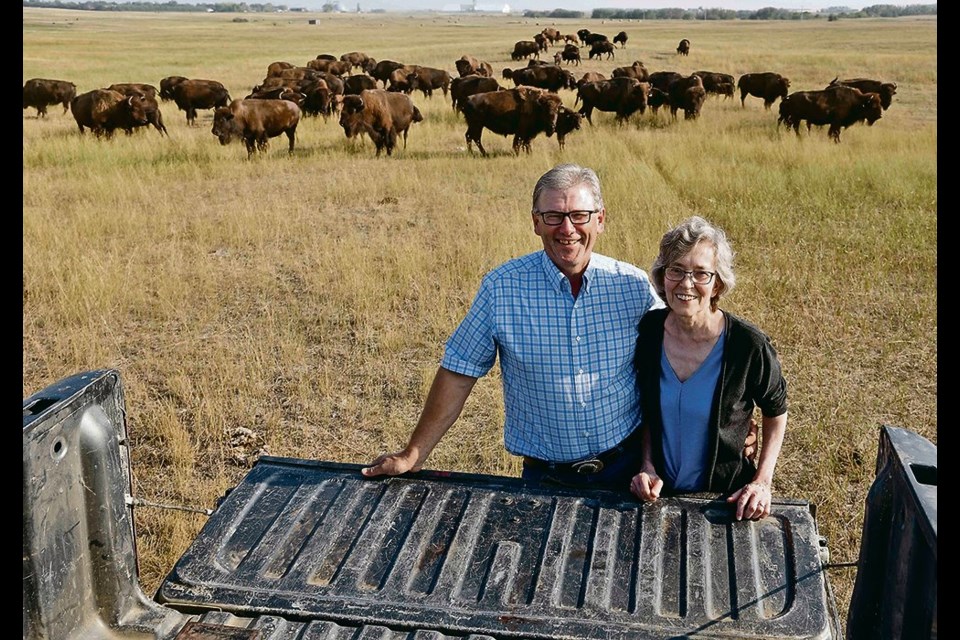HANLEY, Sask. — Sell a bison burger and you’re selling a story. That’s how Les and Kathy Kroeger approach their business and their customers.
“I’ve got my passion for talking about bison and the land. And I sell my story, whether it’s in a package of steak or a package of ground,” said Les.
Kathy emphasizes the heritage of the animal and the ways people view it.
“It’s important that we keep sharing the stories with one another because everybody who comes in contact with bison, to whatever degree, has a story to tell about them,” she said.
The couple operate Rosedale Bison, a 250-head, 1,250-acre ranch bordering the town of Hanley. Part of it was homesteaded by Les’s grandfather, who immigrated from Russia in the 1920s.
Les grew up milking dairy cows with his father, but that mostly ended after they sold a chunk of pasture to make room for construction of the four-lane Highway 11.
“Dad was determined we would never milk another cow. He got the idea of trying bison, so in 1989 we bought our first four bison cows and that began this whole process,” he said.
A few years later, the Saskatchewan Bison Association was established to promote the bison industry and to represent the interests of bison producers, which numbered 24 producers at that time and sits at about 300 today.
Les is a past president of that organization and current president of the Canadian Bison Association, which hosted the International Bison Convention in Saskatoon in July.
“Through those 33 years that we’ve had bison, we’ve seen the evolution of the industry where it’s not the big scary animal. They’re still wild by nature, but we’ve learned with them.”
He credits the late Bud Williams for teaching him low stress handling techniques and ways to work with bison.
“We’ve learned how to read the animals and work with them. We can make the bison go wherever they want, we just have to develop a means to make them want to,” he said.
Kathy is a retired school teacher and administrator. She met Les when she was principal at the local school and now her administrative skills, honed over 38 years in education, are 小蓝视频 utilized as Rosedale Bison’s bookkeeper and record-keeper.
“I’m the brawn and she’s the brains,” said Les with a smile.
The evolution of bison within the Canadian livestock industry requires traceability where every animal that leaves the farm has to have a radio frequency identification (RFID) number.
“It’s a new era we’re moving into where we have to have records of movement on everything, so we have to be able to trace the animals from the consumer right back to the farm of origin,” said Les.
In addition to a five-year drought in the area, the pandemic had further impact on the niche bison meat market.
“The Canadian marketplace has always been typically serving the restaurant industry and the European export. COVID closed the doors on both of those,” said Les.
Burgeoning consumer interest in their homegrown bison meat has been a silver lining for the Kroegers, whose ranch is conveniently located next to one of the province’s major highways.
“Instead of looking for markets for live animals, we’re doing our own processing and selling products ourselves, so we’re expanding into marketing our own product.
“Farmgating has done the whole industry a lot of good. Ever since COVID hit, consumers are eating more bison and finding out more about … cooking the different cuts or the health benefits of the meat,” he said.
A small shop now sits where the old milk house once stood and offers a convenient place for customers to visit and learn — and tell stories. A display case holds storytelling artifacts that Les has collected from his land, including a few hammerheads and bison horns.
“Because of my involvement and my passion for this, I prefer the customers to come here. We can sit and talk about environmental issues, conservation and other different things. They can see what we’re doing and then enjoy some really great tasting products.”
Added Kathy, “people trust local and personal and to be able to come and have conversations about the animal. The animals are beautiful and majestic and they’re incredibly intelligent.
“They’re different from cattle and they’re different from elk and deer because there’s a richness to them, there’s a depth to them and they’re a big part of our Canadian history.”
Les notes their different approaches to marketing.
“Kathy uses mystique. I use romance…. It’s part of the Western culture. The bison have been here for thousands of years. But there’s still that big, powerful romantic animal. (People) want to find out more about that story. It’s not just buying a burger. It’s buying our story, whether it’s thousands of years ago with the First Nations and then with the buffalo hunters.
“I’m not just selling a burger, I’m selling the story. And when somebody buys that burger, they’re supporting me to do more with my part in conservation of grasslands and the species.”




